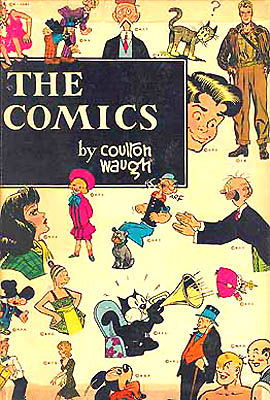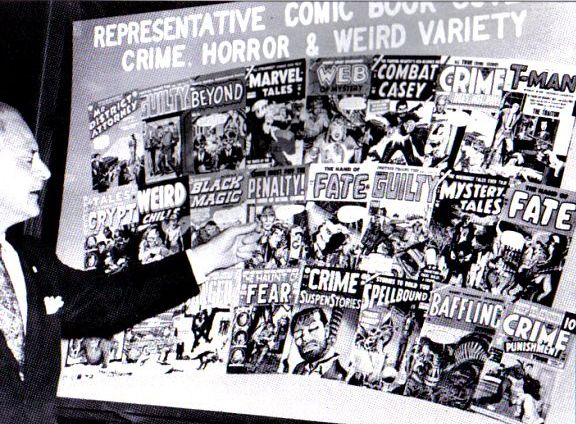|
Timeline of the Anti-comics Crusade
of the 1940's and 1950's
- May 8, 1940- Sterling North's anti-comics editorial, "A National Disgrace," is published in The Chicago Daily News. It would later be reprinted in numerous newspapers throughout the United States.
- 1941- DC Comics forms an editorial board to review its comics. Board members' names and credentials are printed inside DC's comics, in hopes of warding off accusations that their comics are unhealthy for kids.
- January, 1942 (cover date) - National Parent-Teacher publishes "Those Troublesome Comics" by Paul Witty
- 1944 (cover date)- The Journal of Educational 1944-1 publishes "The Viciousness of the 'Comic Book'" by James D. Landsdowne
- 1944 (cover date)- The Journal of Educational 1944-3 publishes "Those Vicious Comics" by James Newell
- December, 1944 (cover date)- The Journal of Educational Sociology devotes an entire issue to comics, featuring such articles as "The Comics as a Social Force" and "Comics and Instructional Methods."
- October 22, 1945 (cover date)- Time magazine publishes "Are Comic Books Fascist?" Read it!
- 1947 (copyright date) - Coulton Waugh's The Comics is published. The book deals primarily with comic strips, but its final chapter is devoted to comic books. It's likely that Waugh's assessment of comic books
provided some of the inspiration for the anti-comic-book sentiment that would grow to prominence starting in 1948.
The comic book chapter opens like this:
We had better add comic books to the list of important developments made in the world in the last ten years. This hurts many people;
it doesn't seem possible that anything so raw, so purely ugly, should be so important. Comic books are ugly; it is hard to find anything to admire about their appearance.
The paper -- it's like using sand in cooking. And the drawing: it's true that those artists are capable in a certain sense; the figures are usually well located in depth, they get
across action... But there is a soulless emptiness to them, and outrageous vulgarity; and if you do find some that seem, at least, funny and gay, there's the color.
Ouch! It seems to be an axiom in the comic-book world that color which screams, shrieks with the strongest possible discord, is good. Even these aspects of comic-book aret are mild and dull when contrasted
with the essence of it: the layout, the arrangement of ideas; and that goes, too, for the ideas themselves.
Click here to read a review from The Saturday Review of Literature.
|

|
- February 17, 1947 (cover date)- New Republic publishes "Junior has a Craving" by Marya Mannes
- December, 1947 (cover date)- McCall's publishes "What do they See in the Comics?" by Selma Robinson
- March 2, 1948- ABC Radio's "America's Town Meetings of the Air" features a debate called "What's Wrong with the Comics?"
Li'l Abner creator Al Capp debates with John Mason Brown, a critic for the Saturday Review of Literature. In this debate, Brown famously calls comics
"the marijuana of the nursery; the bane of the bassinet; the horror of the house; the curse of the kids; and a threat to the future."
Writer and former editor at Vogue and Glamour, Marya Mannes also particpated in the debate, as did George Hecht, publisher of Parents Magazine and True Comics.
- March 19, 1948- Symposium "The Psychopathology of Comic Books" includes Wertham and Love & Death author G. Legman. Read the abstract!
- March 20, 1948 (cover date)- The Saturday Review of Literature prints John Mason Brown's "The Case Against the Comics" and Al Capp's "The Case for the Comics", which were the
opening remarks of the "Town Meeting of the Air" on March 2, 1948. The same issue contains a lengthy review of Coulton Waugh's The Comics. Read it!
- March 27, 1948 (cover date)- "Horror in the Nursery" published in Collier's magazine, citing Dr. Wertham's work. Read it!
- March 29, 1948- The United States Supreme Court, in the case Winters vs. New York, strikes down a law against publishing and distributing
crime publications. In particular, the law had made it illegal to print, utter, publish, sell, lend, give away or show
"any book, pamphlet, magazine, newspaper or other printed paper devoted to the publication, and principally made up of
criminal news, police reports, or accounts of criminal deeds, or pictures, or stories of deeds of bloodshed, lust or crime."
The high court's decision overturned the conviction of a bookseller who had sold the first issue of Headquarters Detective, True Cases from the Police Blotter, from June, 1940.

Following the Winters decision, crime comics flourish.
- March 29, 1948 (cover date)- Time Magazine reports on the "Psychopathology of Comic Books" symposium. Read it!
- April, 1948 (cover date)- Time magazine reports on Detroit Police Commissioner Harry S. Toy, who examined comic books in his community. Toy indicated that they were, "Loaded with communist teachings, sex, and racial discrimination."
- May, 1948 (cover date)- Lev Gleason publishes Biro & Gleason's code of self-censorship in Crime Does Not Pay #63 and Crime and Punishment #2. Read it!
- May 29, 1948 (cover date)- Saturday Review of Literature publishes Wertham's "The Comics... Very Funny!"
- July 1, 1948- The Association of Comics Magazine Publishers adopts the first comics code. Read it!
- July 24, 1948 (cover date)- Saturday Review of Literature publishes a rebuttal to Wertham's criticisms. 14-year old David Wigransky presented a compelling response to Wertham's article. Wigransky's letter was reprinted in Alter Ego #90.
- August, 1948 (cover date)- Reader's Digest reprints a selection from Wertham's Saturday Review of Literature article. Read it!
- August 19, 1948 - Newspapers around the country report on a story that three boys in New Albany, Indiana set out to murder and torture other kids, using ideas they got from comic books. Read it on the front page of the Tuscaloosa News!
- December 20, 1948 (cover date)- Time magazine reports on a comic book burning in Binghamton, NY.Read it!
- 1949 (cover date)- Commentary magazine publishes "Comic Books and Other Horrors".
- February, 1949 (cover date)- Family Circle publishes "What Can YOU do about comic books?".
- February and March, 1949 (cover date)- Marvel's comics contain an anti-Wertham editorial.
- April, 1949 (cover date)- Marvel's comics contain a defense against Wertham's charges.
- 1949- Love & Death by Gershon Legman published.
- 1950- The Cincinatti Parent's Committee began rating nearly all comic books published. These ratings were published annually in Parents' Magazine.
- 1950- The U.S. Government forms a special Senate committee to investigate organized crime. Among the topics of investigation were the effects of crime comics on the population.
- 1950- Mister Mystery #3 contains an editorial in response to Wertham's charges. Read it!
- March, 1951- New York Joint Legislative Committe to Study the Publication of Comics issues its interim report. At SeductionOfTheInnocent.org, we're working on getting a copy
of this report that we can post in full. In the meantime, you can find portions of this report here.
- November, 1953 (cover date)- Ladies Home Journal prints Wertham's article "What Parents Don't Know about Comic Books", which would later become part of Seduction of the Innocent. Read it!
- 1954- EC's last gasp for the "new trend" books.
- February 14, 1954- The Hartford Courant runs the first of a series of four anti-comics articles, titled, "Depravity for Children -- 10 Cents a Copy."
- March 1, 1954- New York Joint Legislative Committe to Study the Publication of Comics issues its 1954 report. Read it.
- April, 1954 (cover date)- Crime SuspenStories #22 published, with a gory decapitation cover that would later be used during Bill Gaines' testimony before the Senate subcommittee.
- April 19, 1954- Seduction of the Innocent published.
- April 21-22, 1954 and June 4, 1954- Senate Subcommitte Hearings on Juvenile Delinquency focus on the evils of comic books.
Read the transcripts of the U.S. Senate Hearings, at TheComicBooks.com.

- June, 1954 (cover date)- Commentary magazine publishes Robert Warshow's essay on EC comics and Wertham, which also references Gaines' Senate testimony. "The Study of Man: Paul, the Horror Comics, and Doctor Wertham".
- August, 1954 (cover date)- EC publishes its famous "Are You a Red Dupe?" editorial.
- September 14, 1954- EC Comics ceases publication of its three horror comics and two SuspenStories comics.
- October 26, 1954- The Comic Magazine Association of America adopts the original Comics Code. Read it!.
- November, 1954 (cover date)- Reader's Digest publishes "The Face of Violence," an anti-comics article.
- March 14, 1955- The Senate Subcommittee issues its report, "Comic Books and Juvenile Delinquency," indicating that it finds the Comics Code to be a step in the right direction.
- 1955- Geoffrey Wagner's Parade of Pleasure published.
- Jan-Feb, 1956 (cover date)- EC publishes its last comic book, Incredible Science-Fiction #33.
- April 9, 1955- Fredric Wertham "It's Still Murder" is published in The Saturday Review of Literature, one of the forgotten anti-comics articles by Wertham Read it!
|
|
| |
Do you have information to contribute?
Or would you like to join our TOTALLY SPAMLESS mailing list?
E-mail us!

|
Further Reading
If you'd like to read more about this period in comic book history, here are some books that you might find useful.
- Hajdu, David The Ten Cent Plague - The Great Comic Book Scare and How It Changed America, Farrar, Straus and Giroux, New York, 2008.
If the great comic book scare interests you, and given that you're visiting this site it probably does, this book is essential reading.
- Nyberk, Amy Kiste Seal of Approval- The History of the Comics Code, University Press of Mississippi, Jackson, MS, 1998.
- Wright, Bradford W. Comic Book Nation- The Transformation of Youth Culture in America, Johns Hopkins University Press, Baltimore & London, 2001.
- Savage, William W. Comic Books and America 1945-1954,University of Oklahoma Press, Norman and London, 1990.
- Beaty, Bart Fredric Wertham and the Critique of Mass Culture, University Press of Mississippi, Jackson, 2005.
- Barker, Martin A Haunt of Fears- The Strange History of the British Horror Comics Campaign, Pluto Press, London and Sydney, 1984.
|
| |



